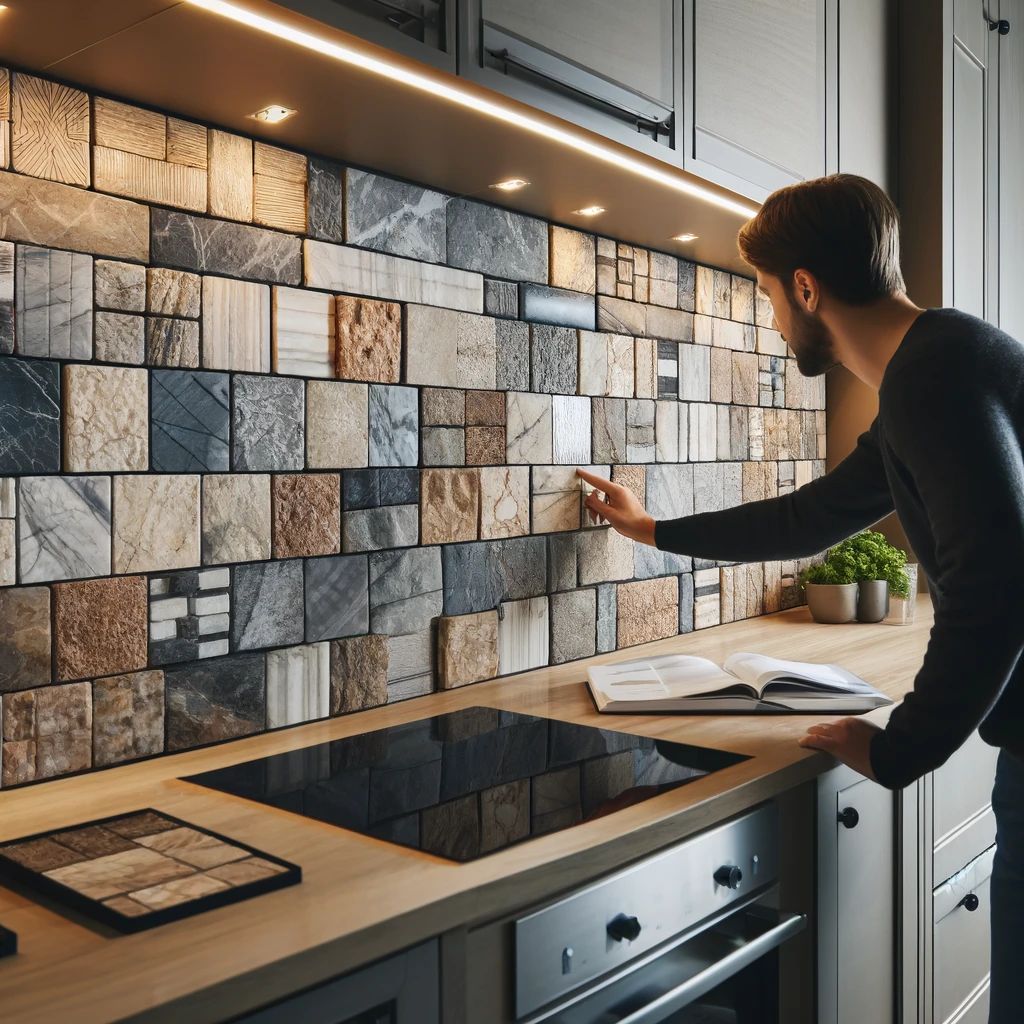
Key Takeaways
- Refinishing your stone tile backsplash can enhance your kitchen’s safety and aesthetics.
- Start by thoroughly cleaning the area and preparing all necessary tools and materials.
- Repair any damage to the stone tiles before polishing to achieve a new, shiny surface.
- Seal your backsplash properly to protect it from stains and extend its lifespan.
- Regular maintenance will keep your backsplash looking great and ensure lasting results.
Revitalize Your Space with a DIY Stone Tile Backsplash Facelift
Let’s face it, the heart of the home deserves to shine, and what better way than giving your kitchen’s stone tile backsplash a do-it-yourself makeover? Not only does it save you a pretty penny compared to a full remodel, but the satisfaction of transforming your space with your own hands is priceless. So, grab your tools, and let’s turn that dull backsplash into a gleaming centerpiece.
Prioritizing Safety: Essential Precautions for Refinishing Natural Stone Tiles
First things first, safety is paramount. When you’re dealing with stone tiles, you want to make sure you protect not just the surfaces around you but yourself as well. Gear up with gloves, goggles, and masks to keep the dust and debris at bay. It’s all about setting the stage for a successful refinishing project.
Transforming Your Kitchen with Simple Tools
Before diving into the nitty-gritty, let’s talk about what you’re going to need. Don’t worry, we’re keeping it simple – no need for fancy gadgets here. Most importantly, you’ll need some basic supplies like cleaners, sandpaper, and a good sealer, which we’ll delve into shortly.
Materials and Tools for Refinishing Stone Tile
Having the right materials and tools is half the battle. You don’t need a lot, but choosing quality over quantity will make a world of difference in the end result.
Must-Have Supplies
Before you start your DIY refinishing project, here’s your checklist:
- A stone-safe cleaner to get rid of grime without damaging your tiles
- Sandpaper or a sanding block to smooth out any rough spots
- Stone polish to bring out that natural shine
- A high-quality sealer to protect your handiwork
- Clean cloths and sponges for application and cleanup
Choosing the Right Sealer
When it comes to sealers, not all are created equal. You’ll want to opt for a sealer that’s appropriate for the type of stone you have. For example, if you’re working with granite, choose a sealer designed for granite. This ensures your tiles are protected without compromising their breathability or color.

Natural Stone Tile Backsplash Refinishing Steps
Now that you’ve got your materials ready, let’s walk through the refinishing steps. Remember, the goal is to create a space that’s not just beautiful, but safe and accessible too.
Step 1: Cleaning and Preparing Your Backsplash
It all starts with a clean slate. You’ll want to remove any grease, soap scum, or residues that have built up over time. Use your stone-safe cleaner and some elbow grease to ensure your tiles are spotless. If you come across any stubborn stains, a poultice made from baking soda and water can do the trick – just apply it to the stain, let it sit, and then rinse it away.
First Steps to a Clean Slate
After cleaning, give your tiles a good rinse and let them dry completely. This is essential because any moisture left behind can interfere with the repair and sealing process. So, take your time and make sure those tiles are bone dry before moving on to the next step.
Dealing with Stubborn Stains
If you’re facing stains that won’t budge on your natural stone tile backsplash, don’t fret. Mix a paste of baking soda and water, apply it to the stain, cover it with plastic wrap, and let it sit overnight. The next day, remove the paste, and you should see a significant improvement.
Step 2: Repairing the Stone Tile
Once your tiles are clean and dry, inspect them for any cracks or chips. These imperfections aren’t just eyesores; they can also harbor bacteria and weaken the integrity of your backsplash.
Filling in Cracks and Chips
For small repairs, a color-matched epoxy or stone filler will do the trick. Apply it according to the manufacturer’s instructions, then let it cure fully.
Apply the epoxy or filler carefully, ensuring it’s flush with the tile’s surface. Any excess can be sanded down once it’s set, so don’t worry if it’s not perfect on the first go.
Step 3: Sanding for a Smooth Surface
If the surface of the natural stone tiles is uneven or rough, you may need to lightly sand it to smooth out imperfections. Do this after your repairs have cured. Use a fine-grit sandpaper and sand in a circular motion. Remember to gently work over the repaired areas.
The goal is to make them indistinguishable from the rest of the tile. A light touch is key here – you don’t want to damage the tile’s surface. Once done, wipe away dust with a damp cloth.
Step 4: Polishing for a Brand-New Shine
With your tiles now repaired and smooth, it’s time for the fun part – polishing. This step is what brings the wow factor, turning your once-dull backsplash into a reflective masterpiece. You’ll need a stone polish suitable for your tile type, and a bit of patience. Apply the polish in small, circular motions, working one section at a time to ensure an even coat.
The Polishing Process
Polishing stone is like ironing a shirt – it’s all about technique. Use a soft cloth and work the polish into the stone. You’ll notice the color deepening and the shine starting to come through. Keep at it until you’ve covered all the tiles, then buff away any excess with a clean cloth. The result should be a glossy, even finish that makes your backsplash look brand new.
Achieving the Desired Finish
Some of us love that high-gloss look, while others prefer a more natural matte. The good news is, you have control over the finish. For a glossier look, add a second coat of polish. If you want to keep it subtle, one coat will do. Just remember, the more shine, the more it’ll show fingerprints and smudges, so consider your kitchen’s traffic when deciding on the finish.
Step 5: Sealing for Longevity
The final step in your DIY backsplash refinishing is sealing. Sealing is like setting your work with a protective spray – it’s what keeps your tiles safe from stains, scratches, and water damage. A good sealant will make your backsplash easier to clean and maintain over time. Be sure to choose a sealant that’s recommended for the type of stone you’re working with, and follow the instructions carefully.
Protective Measures to Consider
When you’re ready to seal, make sure the area is well-ventilated. Apply the sealant with a foam brush or cloth, starting from the top and working your way down. Cover the entire surface evenly and watch for any pooling – these areas can cause discoloration if left unchecked. Allow the sealant to penetrate the stone for the recommended time, then wipe off any excess.
Application Techniques for Durability
For the best results, apply the sealant in a thin, even layer. If your backsplash gets a lot of use, consider a second coat for extra protection. Allow the first coat to dry completely before applying the second. Once you’re done, give the sealant enough time to cure – usually 24 hours – before using your kitchen as normal.

Final Touches and Maintenance
Now that your stone tile backsplash gleams with new life, it’s time to focus on keeping it that way. With the right care, your DIY efforts will pay off for years to come, making every meal prep and coffee break a moment to enjoy your handiwork.
Inspecting Your Handiwork
Once you’ve applied the sealer, take a step back. Inspect every inch for uniformity and ensure there are no drips or uneven patches. If you spot an issue, address it while the sealer is still wet. This is your canvas, and you’re the artist – make sure every detail is to your satisfaction.
Upkeep for Everlasting Beauty
After all this hard work, you’ll want to keep your backsplash in tip-top shape. It’s simple, really – just gentle cleaning and the occasional touch-up. For daily grime, a soft cloth and warm water will do the trick. Avoid acidic cleaners that can etch the surface. Spills? Wipe them up right away to prevent stains. And every now and then, check if it’s time to reseal. Think of it as routine maintenance for your kitchen’s new focal point.
Stick to these guidelines, and your backsplash will remain a source of pride and beauty, reflecting your personal touch and the care you’ve put into your home.

Frequently Asked Questions
Can DIY Refinishing Increase My Home’s Value?
Indeed it can! A polished and well-maintained kitchen can be a game-changer when it comes time to sell. But more than that, it’s about the joy and pride you feel every time you walk into your kitchen. That’s value you can’t put a price on.
How Long Will the New Finish Last?
With the right care, your new finish can sparkle for years. Regular cleaning and resealing every couple of years are key. It’s like caring for a cherished piece of furniture – a little attention goes a long way.
Remember, the frequency of resealing depends on the traffic your kitchen sees. If it’s the hub of your home, you might be looking at resealing more often. It’s all about keeping that protective layer strong and intact.
And if you ever notice the shine starting to fade, a quick polish can bring it back to life. It’s the beauty of stone – with a little love, it stays beautiful.
Are There Eco-Friendly Sealers for Stone Tiles?
Yes, the world of sealers has come a long way, and eco-friendly options abound. Look for products with low VOCs (volatile organic compounds) to keep your home and the environment safe. They’re effective and a responsible choice for your DIY project.
What If My Tiles Are Heavily Damaged?
If your tiles have seen better days, and we’re talking serious damage, it might be time to call in the pros. But for those minor chips and scratches, your DIY skills can handle it. A little filler, some sanding, and polish – you’ll be amazed at what you can fix.
Can I Change the Color of My Stone Tiles?
Changing the color of natural stone isn’t like repainting a wall, but you can enhance it. Color-enhancing sealers can bring out the natural tones in the stone, giving it a richer, more vibrant look. It’s a subtle change, but sometimes, that’s all you need to fall in love with your space all over again.





Leave a Reply